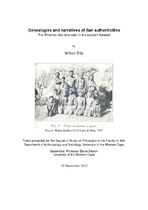| dc.description.abstract | In this thesis, I examine the narratives of authenticity, the limits thereof, the potential interests served by these narratives, and the power relations involved in the promotion of an authentic San identity. I focus on four key areas to achieve this goal: the methodological issues involved in studying authenticity, the framing of the land claim lodged by the San against the Kalahari Gemsbok National Park in South Africa in 1995, the post-land claim settlement activities on the restituted farms, and the various issues around authenticity and traditional leadership. I will also highlight a variety of issues, ranging from livelihoods to governance, community-based natural resource management (CBNRM), identity and ethnicity, and common property debates. The study begins with a brief introduction to the richly textured and highly contested debates and analytical issues concerning the San. Among other things, this first part of the thesis deals with naming, the alleged disappearance of the San, and the eventual reemergence of this group in the post-apartheid landscape of southern Africa. This is followed by a brief description of some aspects of the natural environment of the southern Kalahari and how the San see themselves situated within this cultural–ecological complex. This exploration of the cultural–ecological landscape is not meant to mirror previous San studies of cultural ecology but rather to offer an account of a possible San ontology. The thesis gives an inventory firstly of the research methods applied by myself, and then probes the research encounter reflexively. The main descriptive chapters of the thesis begin with an examination of how the ≠Khomani San emerged onto the political landscape of post-1994 South Africa and how an ethnic entity was constituted through the land restitution process. The post-restitution activities of at least three subgroups of the ≠Khomani San Common Property Association (CPA) are then examined and shown to be a series of contestations and challenges of authenticity. In the final chapter, I take an experimental look at a particular institution that emerged as central to the debates about authenticity and the management of resources in the ≠Khomani San CPA | en_US |

